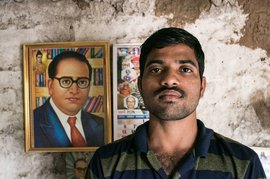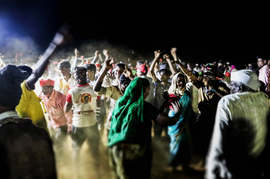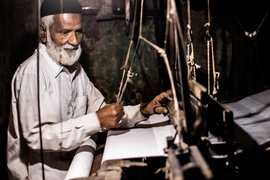Broken stones, fractured bones, remembered songs
PARI volunteer Sanket Jain aims to traverse 300 villages across India and, among other stories, produce this feature: a photograph of a rural scene or event and a sketch of that photograph. This is the seventh in the series on PARI. Draw the slider either way to see the photo or sketch in full
“Bone fractures are a part of the risks in our everyday routine,” says Bhimabai Pawar as she picks up the hammer. Bhimabai, whose wrinkled hands you see in the photo is a landless Dalit worker, a migrant stone crusher from Sindgi (Rural) village in Karnataka’s Bijapur district.
Bhimabai, who is probably in her early 30s, started her migrant journeys around the age of 15. “Every year, we migrate for six months [November-April] to break stones in the villages of Maharashtra,” she says. The remaining six months, she travels within Sindgi taluk to find some work in the fields of others.
She gets Rs. 300 for breaking one brass (100 cubic feet in civil engineering jargon) of stones into smaller pieces. “In the early 2000s, I used to get Rs. 30 for the same work. It takes us two days to break one brass – if the hand is not fractured,” she says.
The back-breaking labour, coupled with poor living conditions, make it a difficult life for the migrants. She stays with her husband in a decrepit yellow-coloured plastic tent that they cart across different work sites.
Bhimabai’s parents worked as agricultural labourers. This photo was taken in Kambalwadi village in Radhanagari tehsil of Kolhapur district, where 10 women from Sindgi (Rural) village were working. The women said that they have worked in the villages of Kolhapur, Satara and Pune districts of Maharashtra. Their husbands also labour as stone workers. The men break huge stones from the nearby hills and bring these to their work site in tractors. The women then break these stones into smaller pieces. The 10-12 men in their group, the women estimate, “are paid Rs. 150 per tractor load, and they manage to break enough stones to fill at least 10 tractors [10 brass] in a day.”
The migrants are accompanied by their children, some of them just infants who usually sleep in hammocks made from sarees. Most of the younger kids drop out of school before reaching the secondary level.
Injuries are common. But, says Bhimabai, “Getting injured is no excuse for stopping work. In the worst case, we have to return to our village.” Sometimes, while the stones are being broken, little slivers or sharp edges from the sides fly off tangentially and injure other workers. “Minor injuries keep happening to us,” says Gangubai, whose left eye was wounded by a small piece of stone.
It’s 4 p.m. in the scorching heat and the sound of stone-breaking suddenly stops. The women decide to relax for five minutes and drink water. They sit in a group, singing a song in the Marwari language, a song dedicated to nature. “Our ancestors migrated from Rajasthan,” they say. “We can speak Marwari, Kannada and Marathi as well.”



